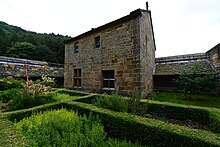

Amonastic garden was used by many people and for multiple purposes. Medieval gardens were an important source of food for households, but also encompassed orchards, cemeteries and pleasure gardens, as well as providing plants for medicinal and cultural uses. For monasteries, gardens were sometimes important in supplying the monks livelihood,[1] primarily due to the fact that many of the plants had multiple uses: for instance, peaches were used for closing wounds.[2]

Concerning the structure of the gardens, they often were enclosed with fences, walls or hedges in order to protect them from wild animals. Even though wealthier monasteries could construct walls that were made out of stone and brick, wattle fences were used by all classes and were the most common type of fence. Occasionally, bushes were also used as fencing, as they provided both food and protection to the garden. Gardens were typically arranged to allow for visitors, and were constructed with pathways for easy access. However, it was not uncommon for the gardens to outgrow the monastery walls, and many times the gardens extended outside of the monastery and would eventually include vineyards as well.[3]
Incorporating irrigation and water sources was critical to keeping the garden alive. In some more complicated systems, the irrigation system used canals to control water-flow.[3] This required that the water source be placed at the highest part of the garden so gravity could aid in the distribution of the water, with smaller canal channels branching out for greater distribution. This was more commonly used with raised bed gardens, as the channels could run in the pathways next to the beds.[3]
When it came to the action of gardening itself, monks of this time typically would use astronomy and the stars to help in calculating the best time of year to plant their gardens as well as the best time to harvest.[4] The tools that were used at the time were similar to those gardeners use today; for example, shears, rakes, hoes, spades, baskets, and wheel barrows were used by monks and are still pivotal to gardening today.
Many medical practices migrated, and assimilated, into medieval Europe from the Islamic world as a result of the Islamic translation effort.[5] As a result, gardening was particularly important for medicinal use.[1][2][4][6] For example, when the peel of the poppy stalk was ground and mixed with honey, it could be used as a plaster for wounds.[2] Other herbs and plants, such as roses, lilies, sage, rosemary and other aromatic herbs, were used for internal complications, such as a headache or stomachache.[3] Almonds were said to aid sleep, provoke urination, and induce menstruation.[2]
In practice, monks used these medicinal herbs not only for themselves, but also to help heal the local community. One prominent healer was Hildegard of Bingen, an abbess who lived in a monastery housing both men and women. Eventually she was elected magistra and would later care for her own secluded monastery.[6] Besides her extensive writing, Hildegard was regularly visited by people throughout Europe, including Henry II of England, the Holy Roman Emperor, and the empress of Byzantium, as well as the local community. Hildegard was seen as the “first woman physician” because of her work as a healer and medical writings.[6]

Monasteries would also rely on their gardens to grow the food the monks needed. There were even monastic gardens that tried to grow produce that was both medically beneficial and appetizing, with vegetables high in starch or in flavor being sought after the most.[7] Some commonly found vegetables include:
| Leek (Allium porum) | Roman Cabbage (Brassica oleracea Botrytis group – Romanesco broccoli) |
| Onion (Allium cepa) | Cauliflower/Cole Wort (Brassica oleracea Botrytis group – cauliflower) |
| Garlic (Allium sativum) | Rapeseed (Brassica napus) |
| Shallots (Shallot) | Turnips (Brassica rapa rapa) |
| Carrots (Daucus carota subsp. sativus) | White Beet (Beta vulgaris) |
| Parsnips (Pastinaca sativa) | Radish (Raphanus raphanistrum subsp. sativus) |
| Chives (Allium schoenoprasum) | Fennel (Foeniculum azoricum) |
| Kale (Brassica oleracea Acephala group– kale) | White Pea (Pisum sativum - Field pea) |
| White/headed Cabbage (Brassica oleracea Capitata group – cabbage) | Green Pea (Pisum sativum - Garden Pea) |
| Heart Cabbage (Description - Cabbage) | Beans (Faba vulgaris)[8] |
In most cases, cemetery gardens were also a type of garden found in medieval monasteries. The vegetation would provide fruit, such as apples or pears, as well as manual labor for the monks as was required by the Rule of Saint Benedict.[8] Cemetery gardens, which tended to be very similar to generic orchards, acted as a symbol of Heaven and Paradise, thus providing spiritual meaning and righteous labor.

The majority of data about monastic gardens can be found in the Middle Ages, primarily through archaeology, textual documentation, and artworks such as paintings, tapestry and illuminated manuscripts. The early Middle Ages brings a surprisingly clear snapshot of gardening at the time of Charlemagne with the survival of three important documents: the Capitulare de villis, Walafrid Strabo's poem Hortulus, and the plan of St Gall which depicts three garden areas and lists what was grown. Further evidence can be found in dilapidated ruins of old monastic infirmaries, where some flowers, like peonies, have been found growing in large patches.[9]
| National |
|
|---|---|
| Other |
|